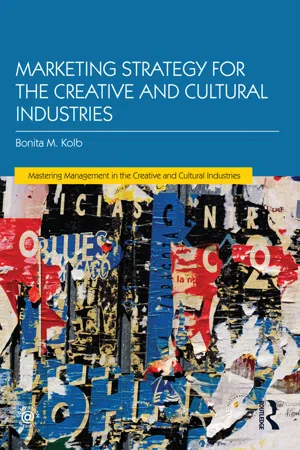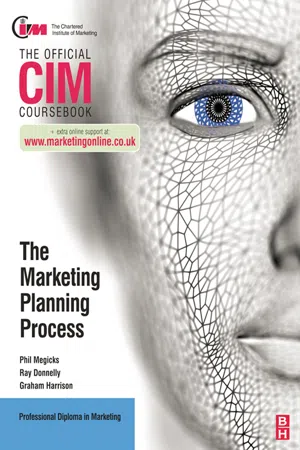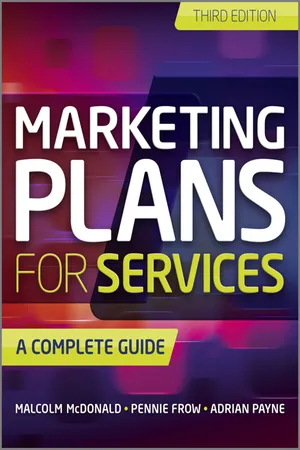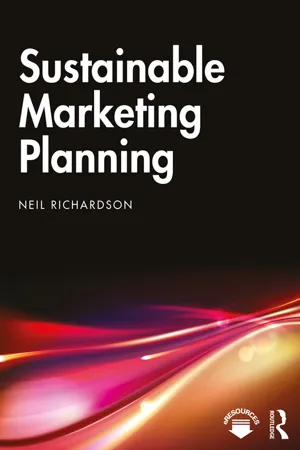Marketing
Strategic Marketing Planning
Strategic marketing planning involves the process of setting goals, identifying target markets, and developing strategies to achieve a competitive advantage. It encompasses analyzing market trends, understanding customer needs, and aligning marketing efforts with overall business objectives. By creating a roadmap for marketing activities, organizations can effectively allocate resources and maximize their impact in the marketplace.
Written by Perlego with AI-assistance
Related key terms
Related key terms
1 of 4
Related key terms
1 of 3
11 Key excerpts on "Strategic Marketing Planning"
- eBook - ePub
- Geoffrey Lancaster, Lester Massingham(Authors)
- 2017(Publication Date)
- Routledge(Publisher)
Below are three which move us from the concept of strategic planning to the focus of this text: that is, strategic marketing. Baker 13 proposes this definition of strategy, illustrating both its directional nature and its military antecedents: ‘Identification of a need which can be satisfied profitably within the constraints and opportunities represented by the potential suppliers’ portfolio of resources, and which is consistent with the organization’s declared objectives.’ Strategies, then, are the outcome of the strategic planning process that Kotler and Keller 14 define thus: Market-oriented strategic planning is the managerial process of developing and maintaining a viable fit between the organization’s objectives, skills and resources and its changing market opportunities. The aim of strategic planning is to shape and re-shape the company’s businesses and products so that they yield target profits and growth. Strategic marketing is defined by Cravens 15 as: A process of strategically analyzing environmental, competitive and business factors affecting business units and forecasting future trends in business areas of interest to the enterprise; participating in setting objectives and formulating corporate and business unit strategy; selecting target market strategies for product markets in each business unit; establishing marketing objectives and developing, implementing and managing program positioning strategies for meeting target market needs. Craven’s definition encapsulates the key elements in strategic marketing. We now expand key steps as a prelude to examining these in more detail. The setting for marketing plans: key considerations Marketing plans take a variety of forms, ranging from verbal intentions or a set of budgets for achievement to formalized structures and procedures used as part of the corporate planning process. We now provide a framework through which we can structure the key steps and inputs to produce a strategic marketing plan - Tony Curtis, John Williams(Authors)
- 2012(Publication Date)
- Routledge(Publisher)
Competing for the Future as ‘an ambitious and compelling dream that provides the emotional and intellectual energy for the journey to the future, conveying a sense of direction and destiny’. Strategic intent is more flexible than a strategic plan and recognizes that the best laid plans may need to change in response to market conditions. The pace of change means that it is not always possible to anticipate change and, for example, cataclysmic events such as September 11 and its aftermath, which was not and could not have been anticipated, can completely transform the business context. The upshot of this is that planning is important but it needs to incorporate flexibility. The days when vast resources were put into creating gigantic strategic plans that were out of date by the time they had been produced are probably over for the present.Marketing PlanningStrategic Marketing Planning is the application of a number of logical steps in the planning process. There are different ways in which this can be done. One specific model would not suit every marketing planning situation. The planning process:Example of a Structure for a Marketing Plan Linked to Corporate PlanningMission StatementMacro-Environment Situational AnalysisPolitical, economic, socio-cultural audits of all major company and technological (PEST) functions – marketing, finance, hrm, production, distribution- Strengths, weaknesses, opportunities, threats, analysis (SWOT)
- Marketing objectives
- Forecast market potential
- Generate marketing strategies
- Assumptions and contingency plans
- Prepare detailed marketing mix programmes
- Budget Resources including staffing
- Agree timescales
- Implement the plan
- Measure and control
In The Discipline of Market Leaders (1995), Michael Treacy and Fred Wiersama argue that there are four new rules that competing companies must obey.1Provide the best offer in the marketplace, by excelling in one specific dimension of value. Market leaders first develop a value proposition, one that is compelling and unmatched.2Maintain threshold standards on other dimensions of value. You can’t allow performance in other dimensions to slip so much that it impairs the attractiveness of your company’s unmatched value.3- eBook - ePub
How to Develop a Strategic Marketing Plan
A Step-By-Step Guide
- Norton Paley(Author)
- 2017(Publication Date)
- Routledge(Publisher)
total system of interacting business activities called for integrating various business activities, such as manufacturing, research and development, promotion, and distribution. Doing so justified the use of strategy teams consisting of individuals from each of those functions. It also reaffirmed the integration already begun through business planning.Managers viewed the marketing planning document as a "housing" to contain all of the above functions and activities in a logical and organized format. Then, to encourage clear and precise communications throughout the organization, the plan became the medium to reach all levels of the organization.By the late 1970s, still another form of planning took hold: Strategic Planning. Strategic Planning aimed to build on to the long-term, financially oriented corporate plans of the 1960s by adding a strategic focus to the process. More precisely:Strategic planning is the managerial process of developing and maintaining a strategic fit between the organization and its changing market opportunities. It relies on developing (1) a mission or strategic direction, (2) objectives and goals, (3) growth strategies, and (4) a business portfolio consisting of markets and products.Corporations still use the generalized terms strategic planning, corporate planning, and business planning. And managers consider them part of a common business vocabulary. Regardless of the term used, the intent shows that volatile environmental, economic, industry, customer, and competitive factors require a more expansive and disciplined strategic thought process for effective planning.No longer could top-down 1950s-style corporate planning driven by a production-orientation plan suffice. The competitive international marketplace of the 1970s required a more precise orientation satisfied by strategic planning and marketing planning. In turn, that planning approach served as a springboard to the next level of planning. - Bonita M. Kolb(Author)
- 2016(Publication Date)
- Routledge(Publisher)
components , product, price, distribution, and promotion, to fulfill both the mission of the organization and the needs of the customer.- The process of writing a marketing plan will force the organization to answer difficult questions. An organization may have many ideas for future action, but as resources are limited, the plan will force the organization to make choices. Goals, objectives, and tactics that provide a roadmap of how to achieve these choices and how success can be measured will then be developed.
The relationship between strategic planning and marketing
New definitions for strategy and marketingThe world is much less static than in the past resulting in a new definition of strategy. Because consumers’ wants and needs constantly change as they access the continual stream of online information, the strategic planning process must be dynamic with constant revision as the plan is being implemented. As each action takes place, consumer feedback is assessed to see if changes must be made before the next step is taken.Strategy old definition : “Create unique and sustainable value by differentiating goods and services.”Strategy new definition : “Find unique, valuable, and sustainable ways of linking together a firm’s knowledge and skills with customers that will benefit from them.”How consumers use products has also changed. In the past, a company would provide instructions on product use and expect them to be followed. Now the consumer decides how to use the product and then shares this knowledge online with others. As a result, the company must provide information that suggests how the product can be used to meet the consumer’s needs but must still understand that each customer is unique and may use the product differently.- eBook - ePub
- Ray Donnelly(Author)
- 2010(Publication Date)
- Routledge(Publisher)
In this chapter, we are going to explore the marketing planning process. Why plan? What is the purpose of the marketing plan? What are the barriers? What should be included in a marketing plan? How do we obtain a competitive advantage from our planning?The marketing plan contains the following stages:- Mission, corporate goals and objectives
- Assessment of the current internal and external situation
- Internal analysis
- Segmentation, targeting and positioning
- Marketing strategy
- Tactical marketing plan
- Marketing budget
- Implementation and performance evaluation
The Synergistic Planning Process
Synergistic planning is the rational process of determining future actions based on a realistic consideration of the current situation and the outcome that is desired.- Desired outcome
- Analysing the current situation
- Designing possible routes
- Deciding what to do and how to do it
- Probability of success
- Resources required
- Acceptability of the proposed action and its implications
- Potential obstacles
The process of planning is not complete when a course of action has been chosen. It is essential to prepare detailed plans for all the groups and individuals involved, which must be integrated in such a way that all action undertaken supports the attainment of the overall objective through implementation of the plan. - eBook - ePub
Marketing Management
Text and Cases
- Robert E Stevens, David L Loudon, Bruce Wrenn(Authors)
- 2012(Publication Date)
- Routledge(Publisher)
Figure 5.2 . This process consists of (1) defining the purpose or mission of the business, (2) developing a set of corporate objectives, (3) formulating a corporate strategy, (4) implementing the strategy, and (5) evaluating and monitoring the strategy to determine if changes are needed in any of the preceding steps. The first three steps are referred to as strategic planning. When these three steps are completed, an organization can prepare its strategic plan, which is the written document that contains the results of these three stages.Figure 5.2. The Strategic Management ProcessOnce the overall corporate- or business-level strategies are developed, the marketing objectives and strategies should be developed. Marketing objectives and strategies must be consistent with the overall corporate objectives and strategies to ensure coordination of plans throughout the organization. A corporate objective of a 20 percent return on investment, for example, would lead to marketing objectives that are also profitability oriented. A corporate strategy that positions a firm as the low-cost producer in an industry may lead to greater emphasis on price in a firm’s marketing strategy.Before discussing marketing planning in more detail, the strategic planning process will be discussed from the standpoint of the whole organization. This will put marketing planning in perspective. Corporate Purpose or Mission Peter Drucker has referred to an organization’s purpose as its mission or reason for being. To define a business’s purpose is to ask,What is our business and more importantly, what should it be? Only a clear definition of the mission and purpose of the business makes possible clear and realistic business objectives. It is the foundation for priorities, strategies, plans, and work assignments. It is the starting point for the design of managerial jobs and above all for the design of managerial structure.1One aspect of every firm’s purpose should be to meet a need in the marketplace. However, a statement of purpose needs to be a formal written statement that spells out in some detail the uniqueness which has led to the creation of the business enterprise. Such a statement becomes a reference point for subsequent managerial action. In effect, it becomes the reference point on which all operating areas in a firm must reflect as a part of their decision-making processes. Typical questions faced by most firms are: Do we enter a particular market? or, Should we introduce a particular product? Answers should be based on how these decisions relate to accomplishing the stated purpose of the organization. If it does not help the organization accomplish its stated purpose, it should not be undertaken, no matter how profitable or otherwise successful it appears to be. A firm’s purpose can be altered over time to reflect changing environmental conditions or changing managerial philosophies, but at any given point there must be a standard of relevance for managerial thought and action. - eBook - ePub
Marketing Plans for Services
A Complete Guide
- Malcolm McDonald, Pennie Frow, Adrian Payne(Authors)
- 2011(Publication Date)
- Wiley(Publisher)
Chapter 5 Marketing planning Phase One: the strategic contextStep 1 Mission A mission for servicesIn each chapter, we will stress the difference between the process of marketing planning and the output of this process – the strategic marketing plan . What should appear in the written output of the Strategic Marketing Planning process was shown in Figure 4.3 in the previous chapter.We have seen that the first phase of the marketing planning process involves determining (or re-examining) the mission statement and setting corporate objectives. In this chapter, we will look at both of these issues in some detail, using examples from the service industry to illustrate how some companies have set about these tasks. Particular attention will be given to the problematic issue of mission development. These two steps form the strategic context and provide the pivotal link between the corporate plan and the marketing plan, as outlined in Figure 4.2.Business strategy is a top management responsibility that involves both identifying the future direction of the organization as well as managing the creative interaction of the functional disciplines of operations, marketing, finance and human resource management. It is both a process and a way of thinking which leads to the development of a set of strategies that assist the business in achieving its corporate objectives.Virtually all companies have a business strategy; however, this may be implicit or explicit. While some companies are successful with only an implicit strategy guiding the chief executive and the management team, it is our experience that companies developing an explicit strategy through a planned approach have a greater chance of long-term success.If the organization has no clear notion about its vision and values, it may be in a quandary regarding the way forwardThe process of business strategy formulation should commence with a review and articulation of the company’s mission. As briefly explained in Chapter 2, the mission (or vision) encapsulates the company’s identity in terms of what it is, what makes it special, what it stands for, and where it is heading. It should explicitly reflect the basic beliefs, values and aspirations of the organization, providing an enduring statement of purpose that distinguishes the organization from its competitors and an important device for coordinating internal activity. - Bonita Kolb(Author)
- 2020(Publication Date)
- Routledge(Publisher)
when each task must be completed by implementing a timeline of goals and accountability.Steps in the marketing strategic planning process
- Where: Assessing the current state of the organization.
- What: Determining goals that must be completed.
- How: Developing the objectives and finding the resources needed to complete.
- Who: Assigning responsibility for completing objectives.
- When: Creating an implementation timeline.
THINK-ACT-PLAN: IntroductionThink: Think about what you want to achieve in your life. Is it to be happy? Is it to make money? Is it to change the community or the world? Which goal has priority? How will it be achieved?Act: Find a creative or cultural organization online or visit an organization with which you are familiar. Describe any evidence of marketing that you see or ask someone at the organization how marketing is used.Plan: Write a short one-paragraph introduction to a marketing plan that explains why it is being written. Be prepared to read the introduction aloud during the next class.COMPONENTS OF MARKETING
Not everyone should receive the same messageCustomizing a marketing message is easier if you know the customer. You can use demographic facts such as age and gender to customize a message or you can base the message on their interest and lifestyles. The problem with online shoppers: they are just a click on your website. Because you know less about them it can be challenging to create a message that will motivate them to the action you desire. Because you can track their online shopping behavior you can use this information to develop and send a unique message.- eBook - ePub
Social Marketing
Principles and Practice for Delivering Global Change
- Gerard Hastings, Christine Domegan(Authors)
- 2023(Publication Date)
- Routledge(Publisher)
progressive and continuous learning is absolutely fundamental to social marketing.Problem definition
The first strategic planning task is to gain a thorough understanding of the problem being tackled. What is the vision for a better, healthier, more sustainable future? What is the desired behaviour change and how will it contribute to this vision? What are the chances of success? Are there better alternative initiatives that could be pursued? Take a look at all the Case Studies and you will see each one begins with a discussion of the problem and how it fits into the broader context.This initial analysis can also help you to answer important ethical questions. As we noted in Chapter 1 , social marketing is powerful, and we need to make sure it is genuinely being used to bring about responsible change. You would, for example, be right to have concerns about working on an intervention which sought to discourage certain groups – poor people, people of colour – from voting, as some Republican-controlled states have been accused of doing in the US.2 Or a project that is tackling a worthwhile issue – say teen smoking – but doing so in a way that is likely to do more harm than good as with the Philip Morris Unsmoke campaign which has been heavily criticised by the World Health Organisation (WHO) for being misleading and potentially encouraging smoking.3 - eBook - ePub
- Marilyn Stone(Author)
- 2007(Publication Date)
- Routledge(Publisher)
The corporate marketing plan will be a subset of the main plan focusing on providing the long-term direction of the organization regarding the markets and needs that will be served and will set goals for the SBUs. Managers within each SBU will devise more specific marketing objectives and programmes in the light of this plan. A schematic map of the planning process is shown in Figure 2.6 Table 2.2 Marketing strategy process: problem-solving process Figure 2.6 The marketing planning process Figure 2.7 SWOT: creating a fit between organization and environment MARKETING AUDIT: EXTERNAL AND INTERNAL ANALYSES The marketing audit involves a systematic and comprehensive analysis of the business marketing environment. Why begin with the environment? If a systems approach is used as a starting point, it is possible to view the organization as an organism which must adapt to changing environmental conditions or die. Organizations are engaged in a battle for survival, which has a dual imperative to meet the needs of customers (Hooley and Lynch, 1985: Kohli and Jaworski 1990: 6; Narver and Slater 1990) and to fend off the competition. The logic is simple. How otherwise could a firm know where it wants to be and compute how it wants to get there if it does not know where it is now and how it got there? Taking the perspective of the organization, if it is to survive in the long run, managers must continually scan the environment to obtain early warning of opportunities that can be taken advantage of, as well as of potential threats to survival. The process of matching is summed up in the simple acronym Strengths, Weakness, Opportunities and Threats (SWOT) analysis. Managers seek to identify the most relevant opportunities and threats that are present in the external environment and to match these with perceived internal strengths and weaknesses - No longer available |Learn more
- Neil Richardson(Author)
- 2019(Publication Date)
- Routledge(Publisher)
3 Sustainable Marketing PlanningAbstractThis chapter will reflect on how marketing planning can drive the adoption of sustainable practices. Have a degree of structure when planning, so some widely used frameworks are discussed. The steps taken in planning are common for many frameworks. Students need to be clear about the terminology, such as the difference between objectives and strategies, because this is the lexicon of marketing practitioners. The role of audits is considered, with practical examples, and many tools/frameworks are critiqued. Students are shown how to create marketing objectives and how to choose the appropriate strategy. Matters relating to implementation and control are addressed. The chapter concludes by considering the barriers to adopting sustainable marketing planning.Learning outcomes
At the end of this chapter, students will be able to do the following:- Differentiate between objectives, strategies and tactics;
- Understand how planning can be applied to a variety of organisations;
- Examine the nature of the internal environments, microenvironments and macroenvironments;
- Assess which tools and frameworks are optimal for analysing the business environments;
- Appreciate how a SWOT summary provides the platform for a TOWS analysis, which is an objective-generating procedure;
- Evaluate the role of segmentation, targeting and positioning (STP);
- Identify the correct strategy to achieve key objectives;
- Explain how the implementation of the marketing mix can be controlled and monitored;
- Reflect on the barriers to implementing sustainable marketing planning.
Many managers struggle to adapt to the relentless changes in technology. If, as Marx suggested, the only constant is change, managers have no option other than to implement changes. The move to sustainable, customer-centric marketing should be one such change. Clearly, what is needed is not change for its own sake but the right
Index pages curate the most relevant extracts from our library of academic textbooks. They’ve been created using an in-house natural language model (NLM), each adding context and meaning to key research topics.
Explore more topic indexes
Explore more topic indexes
1 of 6
Explore more topic indexes
1 of 4










